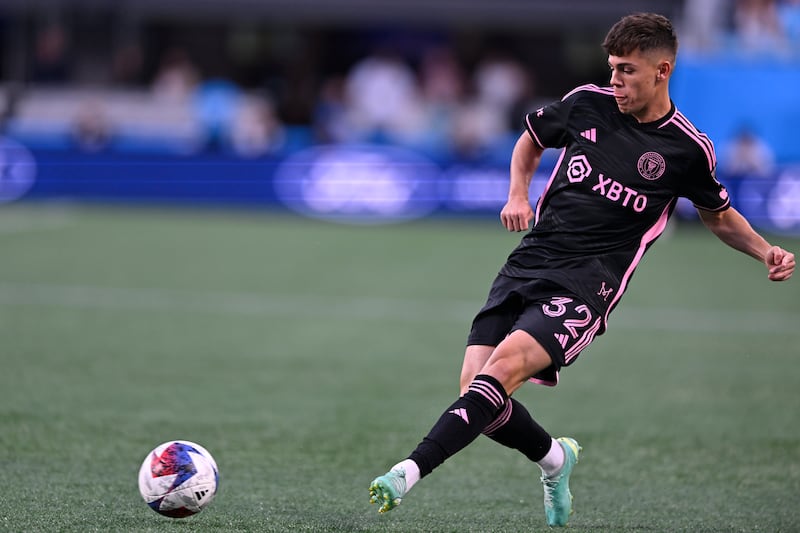Trading as Primark, Penneys touched down on Long Island recently and, in among all the ridiculously cheap tat, showcased a distinctive line of pink and black T-shirts with “Messi 10″ emblazoned across the back. Just up the road, Kohl’s department store started selling branded soccer shirts for the first time in its 62-year history, Inter Miami jerseys suddenly hanging cheek by jowl with New York Giants, Yankees and Knicks paraphernalia. Clothing bearing the Argentinian’s name and image is also available at Target, Wal-Mart and Old Navy as he continues to break new ground, effortlessly colonising America’s retail space.
On television, a smiling Messi pops up as regularly during commercial breaks now as the ubiquitous shill Shaquille O’Neal. One minute, strolling through the car park of Lowe’s complimenting a worker en Español on loading a truck with timber; the next, dribbling a football on a beach while waiting for a Michelob Ultra. With more than a billion dollars in career earnings, his burgeoning endorsement portfolio has him sparking a chant of Oh-Lays in homage to a brand of potato chips (a poor man’s Tayto), and then knocking on the door of Will Smith and Martin Lawrence’s house in a cheesy promo for Bad Boys: Ride or Die.
‘Inter Miami’s creative accountants have somehow found enough loopholes to pay their squad a collective $41 million a season. Just about half of that goes to Messi’
In every ad, he either speaks Spanish or mutters a couple of words in English – “Bad boys” being the limit of his cameo with the movie stars. What he’s saying doesn’t really matter. He’s not flogging his personality. Just his legend, something already so outsized that Americans today pull into petrol stations to find cardboard cut-outs of a bearded South American soccer player standing sentry on the forecourt. And almost everybody here knows who he is because his fame has long ago transcended the sport he has lit up for two decades. This is Pelé at the New York Cosmos, except on an industrial scale in the social media age.
A crowd of 68,455 Georgians watched Messi take on Atlanta United in game two of round one of the elongated Major League Soccer (MLS) playoffs at Mercedes-Benz Stadium last Saturday. His team of superannuated superstars (Jordi Alba and a physically diminished Luis Suarez both started) underperformed and got turned over by a home side featuring one-time Irish international Derrick Williams. Still, his first full season in the league is, according to a lot of metrics, considered a success. His presence has increased attendance and revenues, MLS’s unorthodox exclusive streaming deal with Apple TV has afforded his games a global audience, and clever innovations like a Messi-cam live on TikTok have been eye-catching.
READ MORE
If Sergio Busquets returns from pneumonia, Inter should defeat Atlanta in the rubber match this weekend and could well win the whole thing over the next few weeks. Yet, lingering doubts persist about how all this exactly benefits soccer in this country in the long-term. Messi, club owner David Beckham and Apple are making serious money from the whole enterprise, but Drake Callendar, the goalkeeper, is often the only American in Miami’s star-studded starting line-up. Native player development anyone?

Short-termism was one of the reasons the Pelé experiment only had a fleeting impact back in the 70s, and there’s no future in an Elvis in Vegas policy, relentlessly importing marquee names in their dotage to drive the box office. Growing your own stars should matter more. Twenty-year-old Floridian Noah Allen started last weekend because Busquets was out, but most of the time the promising young Inter Miami starlets gaining valuable experience alongside La Liga icons are lively prospects from Paraguay and Argentina, lads who will soon be sold on to European outfits at a tidy profit.
[ Dave Hannigan: Messi’s bodyguard catching the eye with his continuous shadow playOpens in new window ]
Money, of course, is driving this entire gambit. MLS always boasted a strict salary cap nobly designed to ensure fair competition, but Inter Miami’s creative accountants have somehow found enough loopholes to pay their squad a collective $41 million a season. Just about half of that goes to Messi. His personal wages exceed the total annual salaries of 22 of the clubs he’s competing against. With Busquets on nearly $9 million, Inter’s outlay is two and a half times what Atlanta United (Williams’s three Irish caps earn him $450,000) give their players.
‘The slickness of their global ambition is such that Messi in Miami could be taking place in any country’
In last Saturday’s encounter, Ajani Fortune put in a shift in Atlanta’s midfield, the 21-year-old earning every cent of his weekly wage of $1,300. The astronomical gap between what Designated Players (the term given high-profile imports) and ordinary pros take home has been a troubling issue since the Beckham years in Los Angeles.
It doesn’t unduly bother MLS because this is about branding, not growing a sport. A league supposedly desperate for domestic relevance signed an exclusive television deal with Apple, even though just 11 per cent of Americans subscribe to that streaming service, the suits prizing money and international reach over trying to become mainstream at home.
The slickness of their global ambition is such that Messi in Miami could be taking place in any country. That it happens to be America, in MLS, is entirely incidental because some involved seem more concerned with gaining eyeballs and selling shirts in Asia and beyond.
Inter’s preseason tour touched four continents and included games in Riyadh, Tokyo and Hong Kong. An itinerary that reeked of merchandising and marketeers. To which end, speculation is rife that a broken-down Neymar, the great avatar of what might have been, may join his pal in south Florida this winter. Showbiz never does tire of show ponies.

















